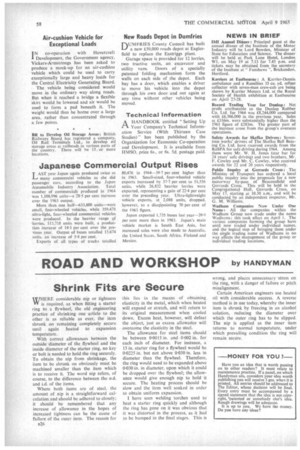ROAD AND WORKSHOP by HANDYMAN
Page 60

If you've noticed an error in this article please click here to report it so we can fix it.
Shrink Fits are Secure
WHERE considerable nip or tightness VV is required, as when fitting a starter ring to a flywheel, the old engineering practice of shrinking one article to the other is as reliable as ever, the item shrunk on remaining completely secure until again heated to expansion temperature. With correct allowances between the outside diameter of the flywheel and the inside diameter of the starter ring, no key or bolt is needed to hold the ring securely. To obtain the nip from shrinkage, the item to be shrunk on obviously must be machined smaller than the item which is to receive it. The word nip refers, of course, to the difference between the o.d. and i.d. of the items.
Where both items are of steel, the amount of nip is a straightforward calculation and should be adhered to closely: it should be remembered that any increase of allowance in the hopes of increased tightness can be the cause of failure of the outer item. The reason for
e26 this lies in the means of obtaining elasticity in the metal, which when heated will expand or stretch, and will return to its original measurement when cooled down. Excess heat, however, will defeat the object, just as excess allowance will overcome the elasticity in the steel.
The allowance for steel items should be between 0.0015 in. and 0.002 in. for each inch of diameter. For instance, a 15 in. starter ring for a flywheel would be 0-0225 in. but not above 0.030 in. less in diameter than the flywheel. Therefore, the ring would need to be expanded above 0-030 in. in diameter, upon which it could be dropped over the flywheel; the allowance would give enough nip to hold it secure. The heating process should be slow and the item well soaked in order to obtain uniform expansion.
I have seen welding torches used to heat a starter ring quickly and although the ring has gone on it was obvious that it was distorted in the process, as it had to be bumped in the final stages. This is
wrong, and places unnecessary stress on the ring, with a danger of failure or pitch misalignment.
Certain American engineers use heated oil with considerable success. A reverse method is in use today, whereby the inner item is shrunk by freezing in an alcohol solution, reducing the diameter over which the outer ring has to be slipped. The nip is applied as the inner item returns to normal temperature, under which prevailing condition the ring will remain secure.




































































































































